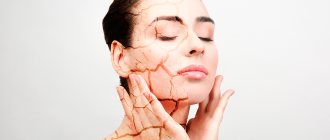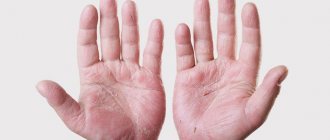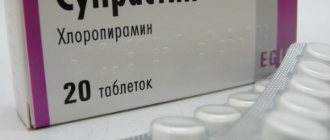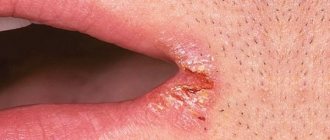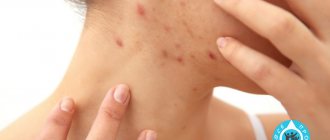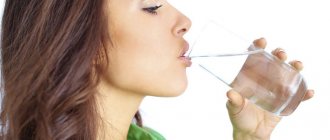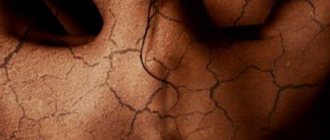Main external reasons
External causes of dry skin include:
- wearing synthetic items (socks, tights, stockings);
- constrictive clothing and shoes;
- oversaturation with sunlight;
- use of cosmetics with a high content of alkalis;
- influence of external aggressive environment (chlorine in the pool, ecology)
Clothing made from synthetic materials can irritate the skin of your feet. The heat exchange process of the skin may be disrupted. Another negative property of synthetics is static electricity. The harm it causes is based on a neuroreflex mechanism. Electricity directly irritates the weakly protected nerve endings of the dermis.
Tight clothing and shoes have a detrimental effect on blood circulation, disrupt the movement of lymph and blood in the tissues, which causes dry skin. If clothing is tight, it interferes with the normal ventilation of the skin, which leads to discomfort, burning, itching and redness. The skin is poorly moisturized and dries.
Tight clothes and shoes cause dry skin
The skin dries and ages when exposed to sunlight. They negatively affect elastin and collagen fibers. Under the influence of ultraviolet radiation, biochemical processes occur in the skin that cause its degeneration. These processes are called photoaging.
Cosmetics with a high alkaline content weaken the pH value of the skin. Trying to restore it, the dermis secretes skin lubricant, which reduces moisture. This destroys the barrier that holds water.
Alkaline cosmetics accelerate transdermal moisture loss. The consequence of this is premature aging. Plus, under the influence of alkali, the dermis is more susceptible to photoaging.
External causes of dry skin include high chlorine content in the pool. It leads to irritation, peeling, and a feeling of tightness. In addition, dry skin can be affected by hard water, which disrupts sebum production.
Another negative external factor is gas pollution in cities. Exhaust gases, penetrating into skin cells, destroy the epidermis, elastin and collagen fibers, activate free radicals, which leads to a decrease in skin elasticity and dryness.
Main internal reasons
The skin of the feet dries out for the following internal reasons:
- diseases;
- problems with blood supply;
- lack of minerals and vitamins;
- age-related changes.
Dryness can be a sign of psoriasis, eczema, diabetes, and fungal infections.
Failures in the blood supply lead to a lack of oxygen, nutrients, and fluid in the tissues. Without receiving these components in the required quantity, the skin dries out.
The reasons for this phenomenon may be related to a lack of vitamins. The main vitamins for combating dry skin are:
- retinol (vitamin A);
- tocopherol (vitamin E);
- B vitamins;
- ascorbic acid (vitamin C);
- biotin (vitamin H).
They moisturize the skin and form new cells. Age-related dry skin is associated with hormonal changes in the body. New cells form more slowly, and old ones do not have time to transform.
Dryness and flaking
The skin on the legs becomes dry and flaky for the following reasons:
- Allergy. An allergen can be a food product, clothing material, dust, or pet hair. If possible, avoid irritants and take antihistamines.
- Stress and overwork lead to the release of cortisol. It changes collagen molecules, which leads to dry and flaky skin.
- External aggressive environment (chlorine in the pool, ecology, ultraviolet radiation).
- Age-related and hormonal imbalances in the body appear after 50 years, which causes dry skin. This happens due to changes in the structure of collagen fibers, which primarily form the epidermis. It is recommended to eat more foods containing collagen and drink clean water to support fat and lipid metabolism.
- Fungal infections that lead to skin irritation and changes in its structure.
In older people, all causes become more acute.
Causes of itching and peeling on the feet
Many people, when visiting a dermatologist, ask the question: why does the skin on their legs peel off? Sometimes your feet peel due to external factors. In other cases, the reason for exfoliation of the skin of the feet is a disorder of the functions of internal systems, infection with pathogens, or simple failure to comply with hygiene requirements. When the problem is detected in a timely manner and it is precisely determined why the feet are peeling, it will be possible to eliminate the problem quickly and without consequences and restore the skin on the feet.
Impact of external factors
Often the feet of an adult become flaky and peel under the influence of external factors. The reason may lie in wearing uncomfortable, low-quality shoes made of artificial materials, and often walking in high heels.
Peeling of the feet is also possible when walking in stockings and socks for a long time. When walking in low-quality shoes, the feet do not breathe properly due to clogged pores.
Sometimes the weather can also cause dry skin. If it is frosty and the humidity is low, adults and children often develop a kind of allergy, which manifests itself in the form of exfoliation of the skin. In this regard, during the cold season you need to take proper care of your feet.
- If cosmetic products contain dangerous additives and are of poor quality, it is possible that the dermis of the feet may dry out and allergic manifestations may develop. In such a situation, additional therapy with antihistamines may be required.
- If cosmetics contain alkaline substances, this also contributes to the formation of dry skin. This phenomenon is often observed with daily use of shower gels.
- Peeling of the skin on the legs is possible due to excessively dry air in the home. To prevent this condition, you need to regularly ventilate the room and use a humidifier.
Wrong diet
Sometimes, in order to understand why the skin on the feet is peeling, it is necessary to diagnose the functions of the internal organs. The cause of dryness and flaking may be impaired metabolism, lack of vitamins and microelements in the body.
Also, problems with the feet may occur due to a lack of fluid in the body. The consumption of smoked meats and pickles also contributes to increased thirst. To prevent changes in the properties of the skin, you should drink at least 2.5 liters of clean water daily, and the consumption of tea and soups is not taken into account.
In addition, exfoliation of the dermis on the feet is possible due to an insufficient amount or excess of beneficial substances. With a lack of vitamins B and D, the skin on the heels flakes and itches, and the skin in the toes area peels off.
Hypervitaminosis can also cause skin peeling. For example, when there is an excess amount of ascorbic acid in the body, the skin often becomes dry.
This phenomenon in some cases is observed due to excess levels of certain microelements in the body.
Pathologies that can cause peeling of the skin on the feet
In some cases, the cause of irritation, lightening and peeling of the soles of the feet lies in infection with fungi. Signs of pathology are detected already in the early stages, when the skin in the foot area itches unbearably.
A fungal infection is also indicated by deformed and thickened toenails. Moreover, the skin not only peels off, but also itches, and painful sensations also appear. In the later stages of infection, a rash and redness of the skin appear.
You can become infected with a fungal disease in a public place through direct contact with a sick person or his clothing or shoes. In addition, infection is possible when visiting a bathhouse, sauna, shower, or swimming pool.
Athlete's foot
A fairly common fungal disease is athlete's foot. Pathology is determined by the appearance of deep cracks between the toes and in the heel area.
In addition, the disease is characterized by the appearance of hyperemia of the skin, intense itching and an unpleasant aroma. The formation of numerous foci of skin exfoliation is noted on the feet.
In the absence of timely treatment, instead of cracks, bleeding wounds appear, as well as deformation of the nail plates.
Rubromycosis of the foot
It is also possible to exfoliate the skin on the feet if infection with rhumbicosis occurs. This is the most popular type of fungus. In addition to the skin between the toes and heels, it affects the lower limbs as a whole.
With this pathology, the appearance of weeping rashes accompanied by itching and burning is noted. In addition, small cracks form in the skin folds in the area of the fingers.
In the absence of timely treatment, the epidermis begins to peel off, numerous wounds form on the feet, which bleed and do not heal well. Infection with this type of fungus occurs during close contact with a carrier of the infection and mutual use of household items.
Candidiasis of the feet
Infection of the feet with Candida fungus is possible only in rare cases. These pathogenic yeast-like fungi are contained by the natural microflora in the body of any person.
When favorable conditions are created, the fungus becomes active and grows sharply. As a result, a focus of inflammation is formed, in some cases localized on the lower and upper extremities.
The formation of a fungal infection is observed against the background of diabetes mellitus, dysbacteriosis, hepatitis C, HIV infection, damage to functions in the gastrointestinal tract, infection in the body that occurs in a chronic form, long-term treatment with antibiotics and other medications.
Damaged skin peels and itches greatly, and after some time small wounds and microcracks appear on the feet. Since the root cause of the activation of the fungus is a disruption of the immune system, the patient needs to increase immunity.
Other factors
There are other reasons that can cause peeling of the feet. Quite often, dermatological problems occur due to excessive sweating. This phenomenon is evidence of damage to the functions of internal organs. In this case, complex therapy may be required.
Psoriasis is a lifelong pathology that also increases peeling of the skin on the feet. It is impossible to cure this disease, however, with the right diet, a healthy lifestyle, as well as the use of certain medications and medicinal external preparations, it is possible to improve the condition.
If a person wears uncomfortable, low-quality shoes, the skin becomes injured and calluses appear, which causes dryness and itching. In addition, the development of cracks in the heels is often caused by impaired functioning of the valves due to varicose veins in the legs.
Peeling of the skin on the feet of children is possible for the same reasons as in adults. But in infancy, separation of the upper layer of the epidermis is possible against the background of the formation of dermatitis.
In addition, the reason for this phenomenon can be wearing clothes made of synthetic fabrics, as well as the use of cheap, low-quality cosmetics.
Dry and itchy feet
Dry and itchy skin on the legs can occur due to a number of diseases: rubella, chicken pox, measles.
Causes of itching:
- Itchy feet can be caused by allergies, such as hives. Another cause of itchy skin on the legs is excess glucose levels in diabetes mellitus.
- With liver diseases, itching of the lower extremities appears. This occurs due to the release of bile into the blood, which affects the nerve endings.
- Impaired blood supply is the cause of itching, accompanied by swelling and heaviness. Acute itching that occurs on the foot and between the toes may be due to a fungal infection.
Cream for the skin between the fingers
Inflamed areas of the skin, cracks of varying depths between the fingers appear due to fungus, diabetes, or gastritis. And also with vitamin A deficiency, prolonged walking, wearing synthetic socks, tights. Which cream will help eliminate the problem depends on the cause of its occurrence. If the skin lesion is not associated with a fungus, you can use the following cosmetics:
- Healing foot cream “Green Pharmacy”
The product has an anti-inflammatory, wound-healing, nourishing, regenerating effect. Thanks to its unique natural composition, it acts gently but confidently. Apply before bedtime. The active ingredients are coconut oil, mineral oil, lanolin, sea buckthorn extract, camphor, menthol, salicylic acid. The cream has a complex effect - heals wounds, restores skin, nourishes with necessary substances, eliminates odor, kills bacteria, and provides a protective function.
- Foot balm “Anti-cracks” from PhytoBioTechnology
Has a healing, antifungal effect. The new formula of the cosmetic product provides a quick effect. The balm contains urea, avocado oil, coconut oil, sea buckthorn oil, beeswax, and lactic acid. Apply every day. It is recommended to use for skin imperfections in patients with diabetes.
Dry skin on feet
Dry skin on the feet is often caused by walking without shoes in the summer. This may be accompanied by the appearance of a fungal infection. One of the main reasons is uncomfortable shoes made from non-natural materials, so the skin does not breathe.
Dry skin on the legs. The reasons may be the appearance of a fungus. It occurs when wearing uncomfortable shoes that do not breathe. It is important to choose quality shoes
This is aggravated by the special skin of the sole, which is thicker than in other areas. Inflammation and cracks can result from insufficient care of the skin of the feet.
Product comparison table
| Product | Action | Dispenser | Consistency |
| DNC cream-wax for feet from cracks and dryness | Healing, deep nutrition. | No | Dense |
| Gehwol ointment for cracks | Healing, softening. | No | Thick |
| Twinstec “Before and After” for cracked feet | Relieving inflammation, restoration. | No | Average |
| Planet Nails "Aqua" | Light hydration. | Eat | Lightweight |
| Beauty Style super moisturizing cream mask | Nutrition, restores. | Eat | Average |
| Kleona natural moisturizing and nourishing cream | Nutrition, hydration. | Eat | Lightweight |
| Nanamus Foot Cream | Toning, light moisturizing. | No | Lightweight |
| Aravia Professional Foot cream for corns Super moisture | Relieving inflammation, smoothing wrinkles, softening. | Eat | Average |
Causes of cracks
The appearance of cracks in the skin of the lower extremities is influenced by:
- Summer footwear. When wearing slates, the sole of the foot may receive impacts and microtraumas. Dry air and hot sand can also have a detrimental effect.
- Uncomfortable shoes and synthetic socks. When using them, the soles of the feet dry out and become cracked.
- Insufficient foot care. You should use baths and remove keratinized epidermis.
- Fungal infections. They are eliminated with antifungal drugs. Shoes should be disinfected.
- Kidney diseases and endocrine disorders.
- Disorders and diseases of the gastrointestinal tract.
To completely cure cracks, it is necessary to find out the cause and take preventive measures.
Leg shine cream
Beautiful, well-groomed legs attract the attention of men and make women jealous. A new range of foot care products allows you to achieve glossy skin like the models from the pages of a fashion magazine.
- Foot cream "Safari"
A highly effective daily care product that makes the skin soft, elastic, silky with a glossy shine. The cream contains soybean oil, lanolin, mink oil. Thanks to the last component, the skin acquires shine, but not a layer of fat, but a glamorous consistency. In addition, the cream provides a full level of moisture, nourishes, refreshes, and restores. Lavender has an excellent tonic effect, camphor is a well-known antiseptic. Pine extract allows you to feel the coolness of the morning forest on your feet.
- Cream Honey Dream
The product is produced in France. Nourishing cream allows the skin to become silky, smooth, without blemishes, small and rough defects. Works great against rough skin. The rich composition of the cream allows you to see the result after the first use. Efficiency is provided by cereal oils, honey, rice bran, shea butter, and echium.
Dry spots on the skin of the legs
Dry spots on the skin of the legs are formed due to a disruption in the functioning of the sebaceous and fatty glands.
This is influenced by factors:
- Allergies to food, medications and other substances (detergents and cosmetics).
- Diseases of the gastrointestinal tract.
- Fungus and similar diseases (various types of lichen).
- Skin disease such as eczema, psoriasis and others.
- Stressful state.
Dry spots also appear due to fluid deficiency and liver dysfunction.
How to choose the right cream
When choosing a foot cream, you need to consider not only its beneficial properties. You should also pay attention to the following characteristics:
- skin type. For a certain type of dermis, individual products are required. A moisturizing cream is ideal for dry skin, and a drying cream for those prone to sweating;
- seasonality. A fatty nutrient will be very useful in winter, an antifungal one in summer.
The statement that a good product cannot be expensive is not relevant here. There are many inexpensive, high quality creams with natural ingredients. They are usually produced in the form of bioactive supplements and sold in pharmacies.
It is worth buying foot cosmetics packaged in tubes or sealed bottles. In jars they quickly deteriorate due to frequent contact with oxygen. There is a high probability of their contamination with pathogenic organisms.
Cream in jars should be used as quickly as possible after opening.
Signs of the disease
Along with dry skin on your feet, other symptoms may appear:
- Separation of a layer of skin due to fungal infections.
- Dermis flows between the fingers.
- Bubbles appear, burst and dry out.
- Acute peeling.
- Psoriatic arthritis.
- A papular rash occurs between remissions.
- There is an irregular structure of the nails.
- Change in color of the dermis.
- Hard nodules form.
The listed symptoms relate to diseases: psoriasis, eczema, mycosis.
Cosmetics for the skin of the feet
Cream "Zorka"
It contains: chamomile extract; vitamins A, E; glycerol. The cream neutralizes inflammation, bacteria, moisturizes and nourishes the skin.
Apply at night on clean feet. It is advisable to wear cotton socks. Frequency of use: 1 time every 3 days.
Cream “Forest Power”
Ingredients: sorbic acid, flavorings, petroleum jelly, floralisin. The cream delivers oxygen to the cells of the dermis, nourishes it, and restores collagen tissue. The product is rubbed into the skin of the feet using massage movements. The procedure is repeated 2 times a day.
Cream “Lekar” with urea
Contains: urea, celandine extract, allantoin, oak bark extract, vitamin E, tea tree essential oil.
The drug softens the dermis of the heels and feet, and eliminates dried calluses. Rub onto clean, dry skin before bed once a day.
Cream "Sesderma"
Ingredients: oat extract, urea.
It has a moisturizing, cleansing, soothing effect on the skin and eliminates itching. The cream should be rubbed in morning and evening, massaging problem areas until completely absorbed.
Rating of foot creams from popular brands
Among all the variety of products, it is difficult to make the right choice. The rating of the most effective means presented below will help you do this.
- Intensive Black Mud Foot Cream
Intensive cream with black sea mud. Produced in Israel. Active components instantly penetrate into the deep layers of the epidermis and improve the condition from the inside. An excellent combination of Black Sea mud with extracts of tea tree, aloe vera, shea butter, olive, coconut, lavender. Price per tube 1440 rub. You can order online.
- Evree Max Repair Foot Care
Regenerating cream for dry, very dry skin of the feet. The main purpose is nutrition and hydration. Country of origin: Poland. Recommended to apply before bed. It has a soothing effect on the skin, and after application you feel a slight cooling sensation. Active ingredients: lavender oil, panthenol, urea, allantoin. The cost of the cream is about 450 rubles. More often they order online.
- Schooll
Cream for removing rough skin and corns. The product is hypoallergenic, for all skin types. Contains urea, natural softening components. The effect is noticeable immediately and lasts about 3 days after one use. Gets rid of corns in a week. It acts comprehensively - nourishes, moisturizes, restores, rejuvenates. Can be bought at a pharmacy. The average price per tube is 500 rubles.
The skin of your feet needs the same care as other parts of your body. A few minutes a day dedicated to your feet will make your skin healthy and your youth lasting!
Therapeutic foot baths
Sea salt bath
Ingredients: warm water, one and a half tablespoons of salt. Dissolve the salt and place your feet in the water for 15 minutes. Then wash off the salt with water and moisturize the skin with cream. It is not recommended to continue the procedure longer, as salt corrodes the dermis.
Red wine bath
Ingredients: water (2 l), red wine (500 ml). After mixing, keep your feet there for 20 minutes. Wipe your feet and apply cream. The bath can be taken once a week.
Bath with medicinal herbs
Ingredients: wormwood, chamomile, mint, calendula, lemon balm. Pour hot water over the herbs and leave for 30 minutes. Keep your legs in the pelvis for no more than 20 minutes. After wiping them, moisten them with cream.
Baking soda and soap bath
Ingredients: baking soda (14 gr.), 15 gr. soap shavings. Stir in water at room temperature. The procedure lasts no more than 15 minutes.
Upon completion, the feet are rinsed with clean water and moisturized with cream.
Streamlining your diet for healthy skin
To maintain healthy skin, the following foods should be present in your diet:
- Fruits and vegetables are orange in color. For example: persimmons, carrots, peaches, pumpkin, apricots. They contain vitamin A, which is necessary for skin cell renewal.
- Citrus fruits containing vitamin C. It promotes collagen formation for proper skin pigmentation and is a strong antioxidant.
- Lettuce and spinach. Vegetables are beneficial for the skin because they contain vitamins A, C, B, E.
- Nuts. They are rich in B vitamins and useful elements such as potassium, cobalt, iron, magnesium, phosphorus, manganese. Thanks to them, fats and proteins are more efficiently synthesized in cells, and new dermal tissues are formed.
- Cereals. They contain B vitamins, proteins, zinc, silicon, selenium, cobalt, copper, potassium. Dietary fiber improves the functioning of the digestive system and removes waste and toxins from the body. Silicon increases turgor and elasticity of the dermis.
- Fermented milk products enhance intestinal motility and normalize its microflora.
- Iron-rich foods. Apples, pomegranates, blueberries, white beans, liver, red meats, seafood. Iron increases hemoglobin, which supplies oxygen to tissues, preventing the effects of toxins and skin aging.
- Omega fatty acids are found in fatty fish, vegetable oils, flax seeds, cod liver, and nuts. Restore the lipid layer that protects skin cells. Saturates the skin with moisture, making it elastic.
- Green tea , being a natural antioxidant, prevents skin aging.
Poor nutrition and fluid deficiency lead to depletion and dryness of the epidermis. Every adult needs to drink at least 2 liters. water per day.
Vitamin complexes
- "Perfectil" . Ingredients: almost all vitamins, copper, biotin, selenium, zinc. The drug counteracts skin aging. Take 1 capsule after meals per day for a month. Between courses there are intervals of 1-2 months.
- "Vitrum Beauty" . Ingredients: vitamins A, D, E, C, B, folic acid, nicotinamide, rutin. Microelements: iodine, iron, manganese, calcium, selenium, boron, zinc, magnesium. The drug restores and strengthens the structure of the dermis. The complex is taken 2 tablets per day after meals. It is possible to increase the dose to 3 tablets.
- "Supradin" . Ingredients: vitamin A, D, E, PP, H, sodium bicarbonate, sucrose, sodium saccharin, mannitol, lemon flavor, tartaric acid. “Supradin” improves the efficiency of metabolic processes and promotes the synthesis of the collagen layer of the skin. The drug is taken 1 tablet with meals 1 time per day. The course lasts 30 days, after which there is a break for a period of 60 to 90 days.
Recipes for medicinal compositions for skin
Moisturizing peeling mask
You will need oatmeal (3-4 tablespoons), sugar, honey, 2 tablespoons of cosmetic oil. spoons. The flakes are ground in a coffee grinder. The remaining components are added and mixed to a dense mass.
Rub the product onto pre-steamed feet using massaging movements and leave on for several minutes. Rinse the mixture with water and apply cream. You can make a mask every day.
Nourishing softening mask
Ingredients: honey, sour cream, full-fat cottage cheese. 2 tbsp. tablespoons of cottage cheese are mixed with sour cream and honey (1 tablespoon each). Rub the mixture into the skin of your feet and leave for 40 minutes. Rinse and moisturize the skin with cream. Repeat the procedure 2-3 times a week.
Mask for exfoliating old cells
Ingredients: oat flour, chopped nuts, sour cream. Flour (3 tablespoons) is thoroughly mixed with nuts (1 tablespoon), sour cream is added, everything is mixed until smooth. Apply to feet and leave for 20 minutes. After this, rinse your feet with clean water, rub your feet with a file and apply cream.
Homemade foot cream recipes
You can prepare an effective remedy yourself. It is possible to select components that do not cause allergies and are suitable in smell and action. Individual foot cream is prepared quickly. All ingredients can be purchased at the pharmacy.
- Mint cream
- Mint oil – 5 g;
- Cocoa butter – 75 g;
- Liquid glycerin – 20 g;
- Stearic acid – 15 g;
- Emulsion wax – 25 g;
- Distilled water – 350 ml.
Mix all ingredients except mint oil. Place in the microwave or in a water bath to melt everything well. Let it cool a little. Add mint. Mix everything well until it has a uniform consistency. You can use a blender for this purpose. Place in a jar. Should be stored in the refrigerator on the bottom shelf.
- Shea butter cream
- Coconut oil – 2 tbsp. spoons;
- Shea butter – ¼ cup;
- Olive oil – 2 tbsp. spoons;
- Vanilla essential oil – 8 drops;
- Peppermint oil – 9 drops;
- Beeswax – 20 g.
Mix all ingredients except essential oil. Heat as in the previous recipe. After cooling, add the remaining ingredients. Mix everything well. Store in the refrigerator.
Nourishing oils and how to use them
- Shea butter (another name is “shea”) moisturizes the epithelium, softens and soothes the skin. Forms a protective layer of the dermis. Should be used before bed: rub in the oil and put on socks.
- Olive oil has a moisturizing effect due to its fatty acid content. Oleic acid promotes hydration and restores the outer layer of the epidermis. The oil is rubbed into the skin and stays on for 1 hour. Be sure to rinse with warm water, as cold water increases dryness of the skin.
- Coconut oil contains acids such as lauric, hyaluronic, more than 7 types of fatty acids, and their triglycerides. They moisturize the epithelium, heal cracks, destroy bacteria, preventing fungal diseases. Before going to bed, the oil is rubbed into the skin, after which it is treated with pumice. It is advisable to wear socks.
Dry skin on the legs, the causes of which are varied, can be eliminated on your own. Vitamin preparations, recipes for moisturizing and nourishing baths, and the use of oils will help with this. It is also important to remember that excessive dryness with other symptoms can be a sign of a developing disease.
Cream for softening the skin of the legs
Softening of the skin occurs due to intensive nutrition, elimination of dead skin areas, and moisturizing. The product in this series is universal. Suitable for daily use.
- Eveline SOS softening cream
A professional cosmetic product helps get rid of rough skin on the heels and small cracks. The active ingredient is wheat germ oil. Vitamins A, E, F stimulate the regeneration process of the skin. Medicinal chamomile extract relieves inflammation and softens the skin. Menthol refreshes and heals wounds. Camphor disinfects and eliminates unpleasant odors. Natural betaine increases skin elasticity. The softening cream relieves painful cracked heels in 7 days of daily use.
- Softening cream NanoCode Callus Remover Feet Gel
The product is great for use in the summer, when rough skin appears due to high heels, open sandals, and sandals. And also for winter, when the cause of hardened areas is tight shoes. The gel has a light liquid structure. It is quickly absorbed and penetrates the epidermis layer. Apply it to clean skin. After 15 minutes, gently rub the keratinized areas with pumice. The gel perfectly refreshes and soothes the skin after a hard day. The composition includes panthenol, glycerin, allantoin, propylene glycol and some other components.
